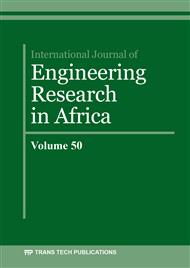[1]
Bosch. Driving-safety Systems - Second Edition. Robert Bosch GmbH, Stuttgart, (1999).
Google Scholar
[2]
J. A. Tamboli and S. G. Joshi. Optimum design of a passive suspension system of a vehicle subjected to actual random road excitations. Journal of sound and vibration, 219:193–205, (1999).
DOI: 10.1006/jsvi.1998.1882
Google Scholar
[3]
O. Kropac and P. Mucka. Be careful when using the international roughness index as an indica-tor of road uneveness. Journal of sound and vibration, 287:989–1003, (2005).
DOI: 10.1016/j.jsv.2005.02.015
Google Scholar
[4]
M. Rozyn and N. Zhang. A method for estimation of vehicle inertial paramrters. Vehicle system dynamics, 48(5):547–565, (2010).
DOI: 10.1080/00423110902939863
Google Scholar
[5]
S. Chantranuwathana and H. Huei Peng. Adaptive robust force control for vehicle active sus-pensions. International Journal of Adaptive Control and Signal Processing, (2004).
DOI: 10.1002/acs.783
Google Scholar
[6]
N. Yagiz and Y. Hacioglu. Backstepping control of a vehicle with active suspensions. Control Engineering Practice, 16:1457–1467, (2008).
DOI: 10.1016/j.conengprac.2008.04.003
Google Scholar
[7]
Sergio Savaresi, Charles Poussot Vassal, Cristiano Spelta, Olivier Sename, and Luc Dugard. Semi-active suspension control design for vehicles. Elsevier, 08 2010. ISBN 0-08-096678-6.
DOI: 10.1016/b978-0-08-096678-6.00019-5
Google Scholar
[8]
H. Imine, N.K. M'Sirdi, and Y. Delanne. Sliding-mode observers for systems with unknown inputs: application to estimating the road profile. Journal of Automotive Engineers, 219, (2005).
DOI: 10.1243/095440705x34658
Google Scholar
[9]
M. Doumiati, J. Martinez Molina, L Sename, O.and Dugard, and D Lechner. Road profile esti-mation using an adaptive youla- kucera parametric observer:comparison to real profilers. Control Engineering Practice, 2016, (2016).
DOI: 10.1016/j.conengprac.2015.12.020
Google Scholar
[10]
A. Arat, M, S. Taheri, and E. Holweg. road profile estimation for active suspension applica-tions,,. SAE Int.J. Passeng. Cars - Mech. Syst., 8(2):492–500, (2015).
DOI: 10.4271/2015-01-0651
Google Scholar
[11]
Hocine Imine. Observation d'´etats d'un v´ehicule pour l'eestimation du profil des les traces de roulement. PhD thesis, Universite´ de Versailles-Saint-Quentin-en-Yvelines, D´ecembre (2003).
Google Scholar
[12]
D. Prattichizzo, P. Marcorelli, A. Bicchi, and A. Vicino. Geometric disturbance decoupling con-trol of vehicules with active suspensions. In IEEE International conference on Control Applica-tions, Trieste, Italy, pages 253–257, september (1998).
DOI: 10.1109/cca.1998.728386
Google Scholar
[13]
C. Wang and T. Lee. Nonlinear dynamic analysis of bi-directional porous aero-thrust bearing systems. Advances in Mechanical Engineeringl, 9(.
DOI: 10.1177/1687814017738153
Google Scholar
[14]
C. Wang, L. Rong-Ma, h. Yau, and T. Lee. Nonlinear analysis and simulation of active hybrid aerodynamic and aerostatic bearing system. Journal of Low Frequency Noise Vibration and Active Control, (3-4):1404–1421, August (2018).
DOI: 10.1177/1461348418792737
Google Scholar
[15]
Y .and Chunxiang W. Liang, L .and Ming and W. Bing. road dna based localization for au-tonomous vehicles,,. in IEEE Intelligent Vehicles Symposium,, pages 883–888., (2016).
DOI: 10.1109/ivs.2016.7535492
Google Scholar
[16]
D. Fischer and R. Isermann. Mechatronic semi-active and active vehicle suspension. Control Engineering Practice, 12:1353–1367, (2004).
DOI: 10.1016/j.conengprac.2003.08.003
Google Scholar
[17]
G. Koch, O. Fritsch, and B. Lohmann. Potential of low bandwidth active suspension control with continuously variable damper. Control Engineering Practice, 18:1251–1262, (2010).
DOI: 10.1016/j.conengprac.2010.03.007
Google Scholar
[18]
J.-H. Lin and C.-J. Huang. Nonlinear backstepping active suspension design applied to a half-car model. Vehicle system dynamics, 42(6):373–393, (2004).
DOI: 10.1080/0042311042000266784
Google Scholar
[19]
H.P. Du, N. Zhang, and J. Lam. Parameter-dependent input-delayed control of uncertain vehicle suspensions. Journal of Sound and Vibration, 317:537–556, (2008).
DOI: 10.1016/j.jsv.2008.03.066
Google Scholar
[20]
M. Boutayeb, M. Darouach, and H. Rafaralahy. Generalized state-space observers for chaotic synchronization and secure communication. IEEE Trans. on Circuits and Systems, 49, (2002).
DOI: 10.1109/81.989169
Google Scholar
[21]
Fenglong Liu. Synth`ese d'observateurs entr´ees inconnues pour les syst`emes non lin ´eaires. doctorat de l'universite´ de basse-normandie, Universite´ de Basse-Normandie, d ´ecembre (2007).
Google Scholar
[22]
A. Hassibi, J. How, and S. Boyd. A path-following method for solving bmi problems in control. American Control Conference,San Diego, California, 2:1385–1389, (1999).
Google Scholar
[23]
Damien Sammier. Sur la mod´elisation et la commande des suspensions des v´ehicules automo-biles. PhD thesis, Institut National Polytechnique de Grenoble (INPG), Novembre (2001).
Google Scholar
[24]
M.C. Smith and F.C. Wang. Controller parametrisation for disturbance response decoupling: Application to vehicle active suspension control. IEEE Transactions on Control Systems Tech-nology, 10(3):393–407, (2002).
DOI: 10.1109/87.998029
Google Scholar
[25]
D. Maquin and J. Gaddouna, B.and Ragot. Estimation of unknown inputs in linear systems. American Control Conference, 1:1195–1197, (1994).
DOI: 10.1109/acc.1994.751939
Google Scholar
[26]
A. Stotsky and I. Kolmanovsky. Simple unknown input estimation techniques for automotive applications. American Control Conference, pages 3312–3317, (2001).
DOI: 10.1109/acc.2001.946139
Google Scholar
[27]
F E Saber, M Ouahi, and A Saka. Unknown-input observer for vehicle lateral dynamics using new sensor force technology. International Journal of Vehicle Systems Modelling and Testing (IJVSMT), 13:199–222, 08 (2019).
DOI: 10.1504/ijvsmt.2019.101542
Google Scholar
[28]
F E Saber, M Ouahi, and A Saka. Estimation of steering wheel angle and vehicle lateral state from measured lateral forces. International Journal of Engineering Research in Africa, 39:14–31, 12 (2018).
DOI: 10.4028/www.scientific.net/jera.39.14
Google Scholar
[29]
Stephen Boyd, Laurent El Ghaoui, Eric Feron, and Venkataramanan Balakrishnan. Linear ma-trix inequalities in system and control theory. studies in applied mathematics. SIAM, Philadel-phia, PA, (1994).
DOI: 10.1137/1.9781611970777
Google Scholar
[30]
D. Lechner, Y. Delanne, G. Schaefer, and V. Schmitt. M´ethodologie de validation du logiciel de dynamique automobile callas. Ing´enieurs de l'automobile, 9(713):10–38, (1997).
Google Scholar
[31]
P. G. Adamopoulos. Road Roughness and Dynamic Response of Road Vehicules. PhD thesis, Institute of Sound and Vibration Research University of Southampton, June (1988).
Google Scholar


